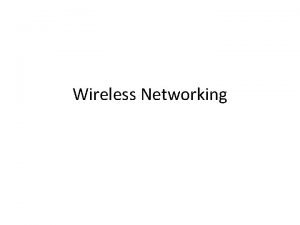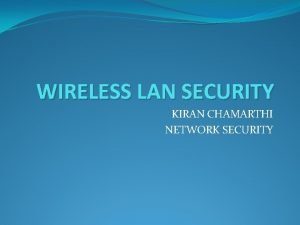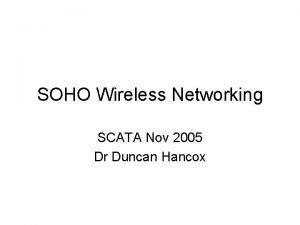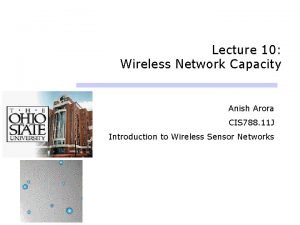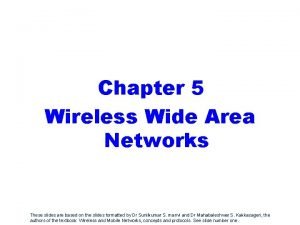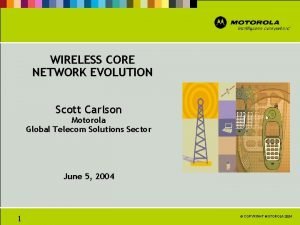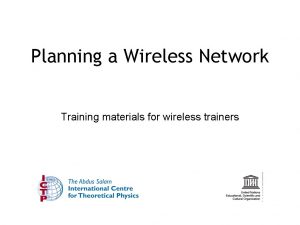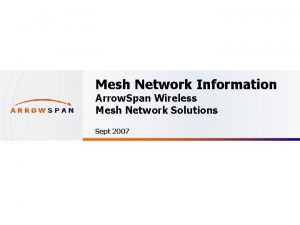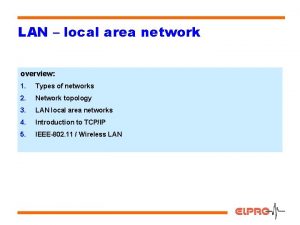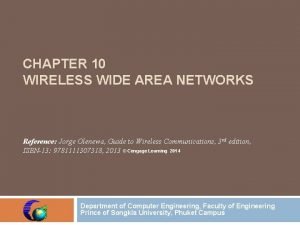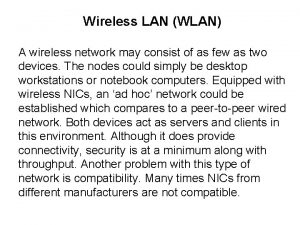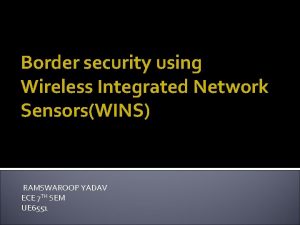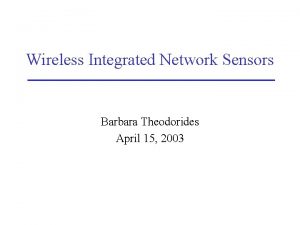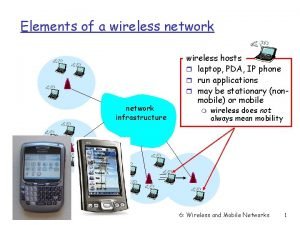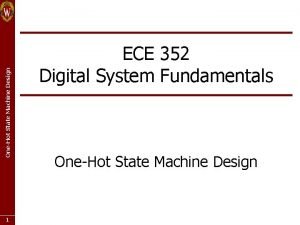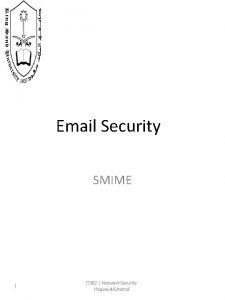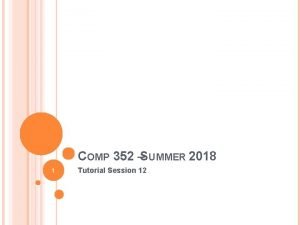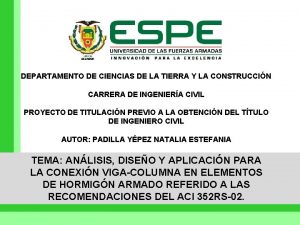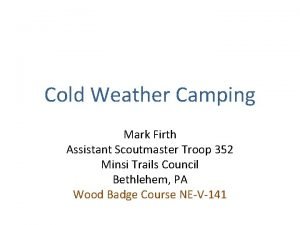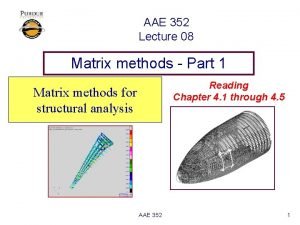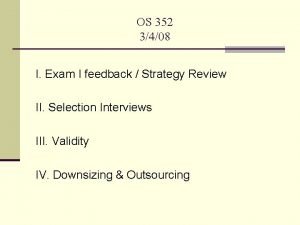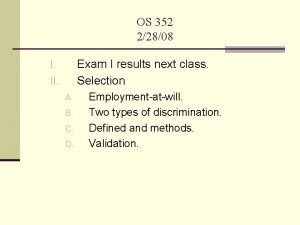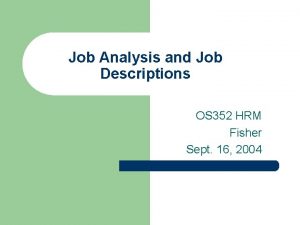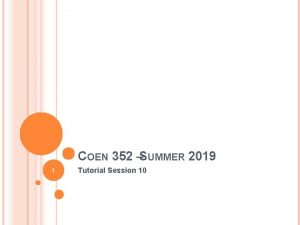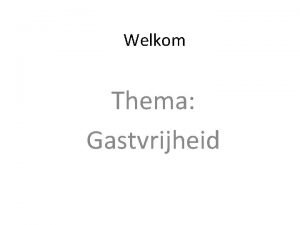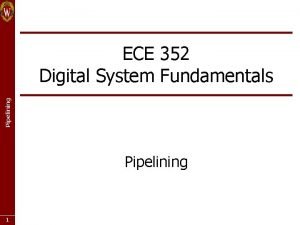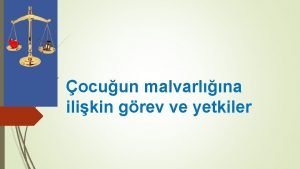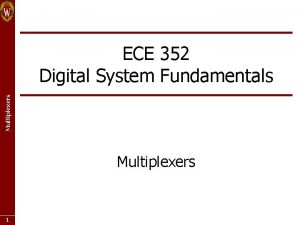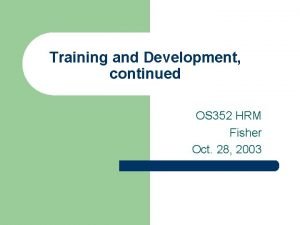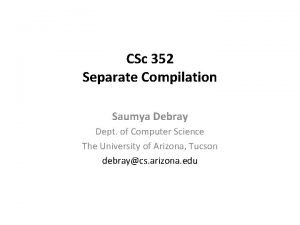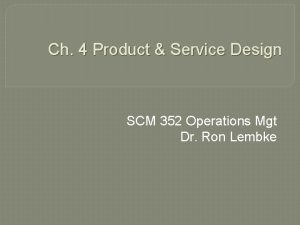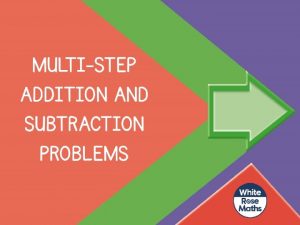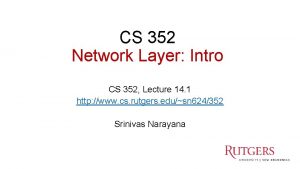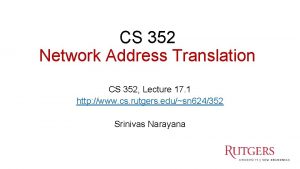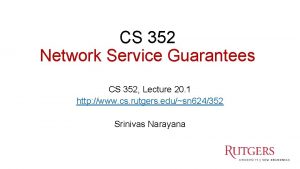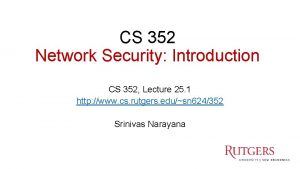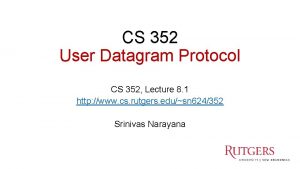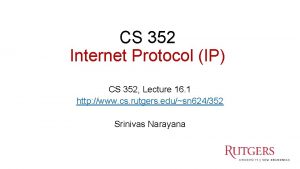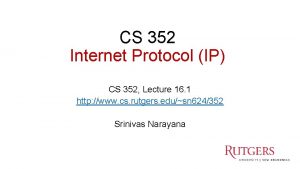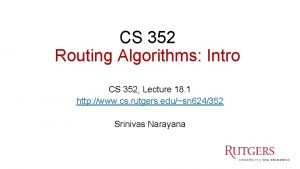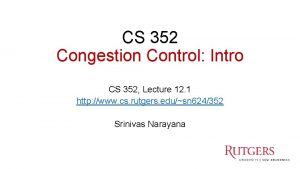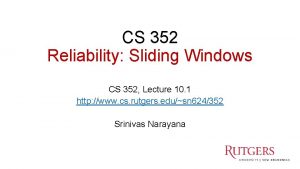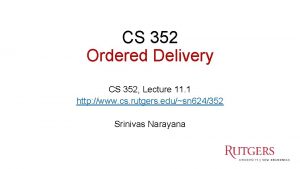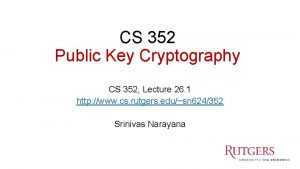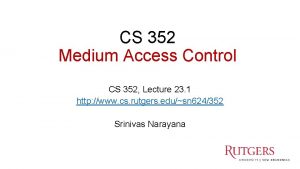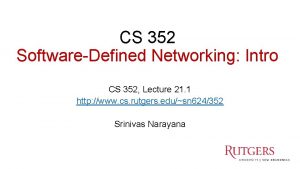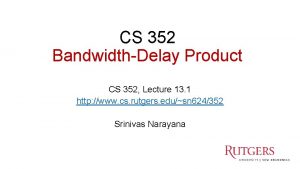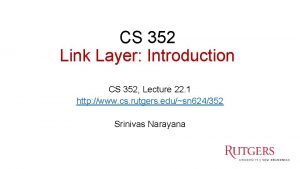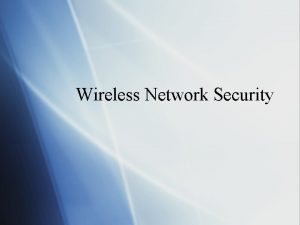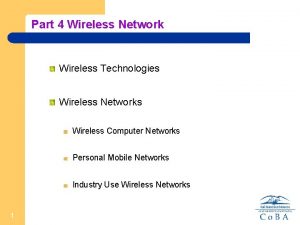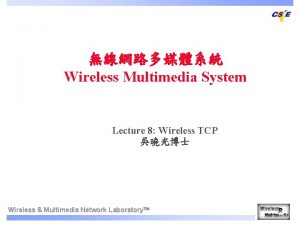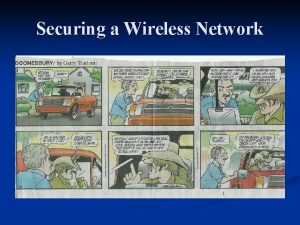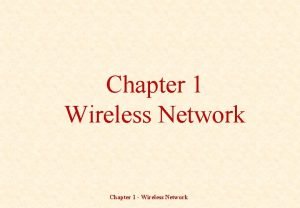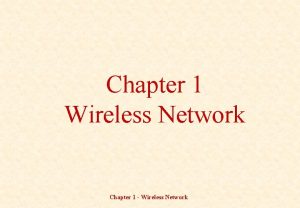CS 352 The Wireless Network CS 352 Lecture













































- Slides: 45

CS 352 The Wireless Network CS 352, Lecture 24. 1 http: //www. cs. rutgers. edu/~sn 624/352 Srinivas Narayana 1

Link layer Application Transport HTTPS FTP HTTP DNS UDP TCP IP Network Link SMTP 802. 11 802. 3 … ATM Ethernet The main function of the link layer is link-local delivery: getting packets from one side of the link to the other.

Wireless and mobile networks

Wireless and mobile networks • # wireless (mobile) phone subscribers now far exceeds # wired phone subscribers • # wireless Internet-connected devices far exceeds # wireline Internet-connected devices • laptops, Internet-enabled phones promise anytime untethered Internet access • Your refrigerator, microwave, and car are connected • Two important (but different) challenges • wireless: communication over wireless link • mobility: handling the mobile user who changes point of attachment to network

Elements of a wireless network infrastructure

Elements of a wireless network wireless hosts § laptop, smartphone § run applications § may be stationary (nonmobile) or mobile network infrastructure • wireless does not always mean mobility

Elements of a wireless network base station network infrastructure § typically connected to wired network § relay - responsible for sending packets between wired network and wireless host(s) in its “area” • e. g. , cell towers, 802. 11 (Wi. Fi) access points

Elements of a wireless network wireless link network infrastructure § typically used to connect mobile(s) to base station § also used as backbone link § multiple access protocol coordinates link access § various data rates, transmission distance

Wireless network taxonomy single hop infrastructure (e. g. , APs) no infrastructure (ad-hoc) host connects to base station (Wi. Fi, cellular) which connects to larger Internet no base station, no connection to larger Internet (Bluetooth, ad hoc nets) multiple hops host may have to relay through several wireless nodes to connect to larger Internet: mesh net no base station, no connection to larger Internet. May have to relay to reach a given wireless node MANET, VANET

Characteristics of Wireless Networks

Important differences from wired links • Decreased signal strength: radio signal attenuates as it propagates (path loss) • Interference from other sources: standardized wireless network frequencies (e. g. , 2. 4 GHz) shared by other devices (e. g. , phone); devices interfere • Multipath propagation: radio signal reflects off objects ground, arriving at destination at slightly different times • These factors make communication across (even a point to point) wireless link much more challenging

Error-prone channel 10 -1 10 -2 10 -3 BER • SNR: signal-to-noise ratio influences the bit error rate (BER) • larger SNR: easier to extract signal from noise. Larger SNR is good. • Increasing signal transmission power increases SNR, decrease BER • Choose physical layer parameters (modulation technique, rate, etc. ) based on least BER for a given SNR • SNR may change with mobility and over time 10 -4 10 -5 10 -6 10 -7 10 20 30 SNR(d. B) QAM 256 (8 Mbps) QAM 16 (4 Mbps) BPSK (1 Mbps) 40

Hidden terminal problem § B, A hear each other § B, C hear each other An obstacle C § However, A and C cannot hear each other A § A and C are unaware of interference at B § Distinction from, e. g. , shared (wired) Ethernet: everyone can hear everyone else B

Hidden terminals due to attenuation • A different version of the hidden terminals problem occurs just due to signal weakening (attenuation) • Path loss: radio frequencies weaken as they travel through space • B, A hear each other • B, C hear each other • A, C can not hear each other interfering at B A B C C’s signal strength A’s signal strength space

Exposed terminals • B is transmitting to A • C wants to transmit to D • However, C can hear B, and chooses not to transmit to avoid interfering • Due to signal attenuation, D won’t be affected by B’s transmission • Nor will A be affected by C’s transmission • Yet, C won’t transmit ? ? A B C C’s signal strength D B’s signal strength space

Wireless LANs • Protocols standardized by the IEEE 802. 11 standards • E. g. , 802. 11 b, 802. 11 g, 802. 11 n, 802. 11 ax • Two associated frequency spectra: 2. 4 GHz, 5 GHz. • All have infrastructure and ad-hoc versions • A host associates with an access point (AP) using beacon frames that are periodically transmitted by the AP • They all use CSMA/CA for multiple access • Subject of the next module! • Cellular networks standardized by a different body (3 GPP) • We’ll see an overview later this lecture


CS 352 Wireless Multiple Access: CSMA/CA CS 352, Lecture 24. 2 http: //www. cs. rutgers. edu/~sn 624/352 Srinivas Narayana 18

Review Medium access control A distributed algorithm running at nodes to determine who should transmit over a shared link Channel Partitioning Random access Turn taking

Review: Shared Ethernet: CSMA/CD 1. NIC receives data to send (e. g. , from network layer), creates a frame 2. If NIC senses channel idle, starts frame transmission. If NIC senses channel busy, waits until channel idle, then transmits (CSMA) 3. If NIC transmits entire frame without detecting another transmission, NIC is done with frame. 4. If NIC detects another transmission while transmitting (collision), the NIC aborts the transmission and sends a “jam signal” (CD) 5. The NIC attempts to retransmit after a period dictated by binary exponential backoff After m’th collision, NIC chooses K at random from {0, 1, 2, …, 2 m-1}, and waits K*512 bit times.

Review: Shared Ethernet: CSMA/CD 1. NIC receives data to send (e. g. , from network layer), creates a frame This is hard to do in 2. the If NIC sensessetting. channel idle, wireless starts frame transmission. If NIC senses channel busy, waits until channel idle, then transmits (CSMA) 3. If NIC transmits entire frame without detecting another transmission, NIC is done with frame. 4. If NIC detects another transmission while transmitting (collision), the NIC aborts the transmission and sends a “jam signal” (CD) 5. The NIC attempts to retransmit after a period dictated by binary exponential backoff After m’th collision, NIC chooses K at random from {0, 1, 2, …, 2 m-1}, and waits K*512 bit times.

Sensing wireless collisions is hard • A node’s own transmission is far too powerful compared to any of the other nodes’ transmissions at the receiving antenna • It’s like trying to hear someone’s whisper when you’re screaming at the top of your voice. You can’t hear it. • A wireless node cannot receive at sufficiently high SNR when its own local transmitter is transmitting. * • Effect: Can’t sense the channel while transmitting! C • It’s hard to sense all wireless collisions anyway • Hidden terminal problems! A * Until recent advances in full-duplex wireless B

Wireless MACs: Avoid collisions as much as possible, since you can’t detect them. Carrier Sense Multiple Access with Collision Avoidance (CSMA/CA)

CSMA/CA Sender 1. NIC receives data to send 3 b. Timer counts down only when the (e. g. , from network layer), channel is idle. When the timer creates a frame expires, transmit. 2 a. If NIC senses channel idle 4. If no ACK received for a fixed time interval (SIFS), increase the random (DIFS), transmit the entire backoff interval. Go to step 2. frame. Then go to step 4. (CSMA, but no CD) DIFS receiver data 2 b. If NIC senses channel busy, start a binary exponential SIFS sender backoff timer. ACK

Important aspects of CSMA/CA

(1) Link-level reliability • The protocol requires the receiver to send ACKs upon successfully receiving frames • The sender has no other reliable way of knowing that a frame was successfully received on the other side of the link • Hidden terminal problems C A • A nice optimization: wireless medium has higher bit error rates • More efficient than waiting for a TCP timeout • TCP-only solution might waste bandwidth on other links and wait entire RTT (rather than link delay) before detecting the error B

(2) Inter-frame spacing • DIFS: Distributed Inter-Frame Space • SIFS: Short Inter-Frame Space • Every node waits “a little extra” before transmitting. Inefficient? • But these “spaces” help prioritize some transmissions • Example: ACKs have higher priority than fresh transmissions • Standards set SIFS < DIFS. So ACKs will get a chance to transmitted before fresh data

(3) Conservative backoff (than CSMA/CD) • If the medium is sensed busy, nodes immediately enter backoff • Compare with CSMA/CD: nodes will wait for idle channel, then transmit immediately without entering backoff • Intuition: avoid collisions by having different nodes wait different periods after medium is detected busy • Further, the timer only counts down when the medium is idle • Defer transmissions when there are other active transmissions • The backoff timer counts the medium’s purely-idle time

Using medium reservations to further avoid collisions

Typical wireless deployment • There’s infrastructure: access point (AP) • Nodes are mostly communicating with the AP, not among each other • Can the AP help resolve collisions across nodes?

Reserving channel with small packets • Idea: let senders reserve the channel, rather than compete and waste channel capacity • Sender first transmits a small request-to-send (RTS) packet to the AP using CSMA • RTSs may still collide with each other (but they’re small) • AP broadcasts clear-to-send (CTS) in response to RTS • CTS heard by all nodes • The node that’s allowed to send transmits data frame • Other nodes defer transmissions

RTS-CTS exchange A B AP RTS(B) RTS(A) backoff reservation collision RTS(A) time CTS(A) DATA (A) defer ACK(A)

Prioritizing using inter-frame spacing • CTS is a high priority frame • The data frame following a CTS is also considered high priority • Node already reserved the channel to transmit • Both use the short inter-frame spacing (SIFS) before transmission begins • Transmit before a fresh RTS or data transmission, which must wait a DIFS interval

Reserving channel with small packets • Net effect: Avoid collisions of (larger) data frames completely, saving significant channel resources • An instance of receiver-driven collision avoidance • CTS: Nodes transmitting to AP aware of each other • No hidden terminal problems • Tradeoff: increased delay before transmission • RTS must be cleared with a corresponding CTS CTS

Summary of CSMA/CA • A random-access method building on CSMA/CD: • More checks and balances to avoid collisions as much as possible • Not possible to detect collisions effectively • Key ideas: link-level reliability, inter-frame spacing, enter backoff when medium busy • In infrastructure mode, can reserve the channel with RTS/CTS to avoid (data frame) collisions • Receiver-driven collision avoidance: no hidden terminals


CS 352 Cellular, 5 G: An Overview CS 352, Lecture 24. 3 http: //www. cs. rutgers. edu/~sn 624/352 Srinivas Narayana 37

Components of a cellular network MSC cell covers geographical region v base station (BS) analogous to 802. 11 AP v user equipment (UE), i. e. , cell phones attach to network through BS v air-interface: physical and link layer protocol between the UE and BS v connects cells to wired tel. net. v manages call setup and mobility v Mobile Switching Center Public telephone network, Internet Mobile Switching Center wired network

The first hop • Sharing the UE-to-BS radio medium occurs using all the channel partitioning MAC techniques we’ve learned! • Combined TDMA/FDMA/CDMA • Divide channel into multiple frequency subchannels (subcarriers) and time slots frequency • Can use CDMA across users during bands same time slot and frequency • Radio resource blocks (time + frequency) allotted to users time slots

Cellular network generations • 1 G (1980 s): analog voice • 2 G (1990 s): digital voice and CDMA • 3 G (2000 s): mobile data • Data network in parallel with voice network • 2 G voice network unchanged • 4 G/LTE (2010 s): mobile broadband speeds • No voice-data separation: everything is IP • 5 G: (2020 s)

5 G: the next generation • Goals: • • higher data rates (throughput) lower delays more energy efficient network more robust to failures and errors • Designed to support novel applications • • • Precision agriculture Health Warehouse automation Drones …

What’s new/better in 5 G? • More radio frequencies to transmit over • Higher frequency spectrum (25 GHz+ millimeter wave) • Shared spectrum below 6 GHz for low energy use cases • More antennas, directional antennas • Massive MIMO: Multiple antennas to share the channel spatially • Focus energy directionally for efficiency: beamforming • More base stations • Higher frequency signals propagate less further out • Picocells: coverage for small areas in dense urban deployments Informational content. Not on the test.

What’s new/better in 5 G? • Coding and error detection techniques: • e. g. , Low-density parity codes (LDPC) • Modulation techniques: e. g. , 256 QAM • Link duplexing: a combination of time-division duplexing (TDD) and frequency-division duplexing (FDD) • Energy-efficient uplink multiple access (RSMA) • Mobility managed primarily by the infrastructure, not the device • Handle more handoffs between base stations more energy efficiently Informational content. Not on the test.

Summary of cellular technologies • Evolving over multiple generations, once every ~10 years • Use physical layer, MAC, error detection and correction techniques specific to that context • You’ve seen simpler instances of these technologies • 5 G: coming soon to your cellular network!

 What are wireless devices and the wireless revolution
What are wireless devices and the wireless revolution 01:640:244 lecture notes - lecture 15: plat, idah, farad
01:640:244 lecture notes - lecture 15: plat, idah, farad Wireless network definition
Wireless network definition Wlan network
Wlan network Soho network definition
Soho network definition Wireless security in cryptography
Wireless security in cryptography Receiver sensitivity
Receiver sensitivity Wireless sensor network protocols
Wireless sensor network protocols Wireless wide area networks
Wireless wide area networks Dilbert wireless network
Dilbert wireless network Earth.google.c
Earth.google.c Outdoor wireless mesh network design
Outdoor wireless mesh network design Lan type a
Lan type a Wireless sensor network ppt
Wireless sensor network ppt Wireless wide area network
Wireless wide area network Wireless network management software
Wireless network management software Wireless network components
Wireless network components What does a wireless lan (wlan) act as to a wired network?
What does a wireless lan (wlan) act as to a wired network? Wireless integrated network sensors
Wireless integrated network sensors Wireless integrated network sensors
Wireless integrated network sensors Elements of a wireless network
Elements of a wireless network Graph neural network lecture
Graph neural network lecture Telecommunication network management lecture notes
Telecommunication network management lecture notes Ece 352
Ece 352 It 352
It 352 352 formação
352 formação Comp 352
Comp 352 Union viga columna hormigon armado
Union viga columna hormigon armado Troop 352
Troop 352 Aae 352
Aae 352 Exam feedback examples
Exam feedback examples Os 352
Os 352 Os 352
Os 352 Coen 352
Coen 352 Wees stil voor het aangezicht van god
Wees stil voor het aangezicht van god Ece 352
Ece 352 Tmk 352
Tmk 352 Ece 651
Ece 651 Os 352
Os 352 Csc 352
Csc 352 Scm 352
Scm 352 Hát kết hợp bộ gõ cơ thể
Hát kết hợp bộ gõ cơ thể Bổ thể
Bổ thể Tỉ lệ cơ thể trẻ em
Tỉ lệ cơ thể trẻ em Chó sói
Chó sói


